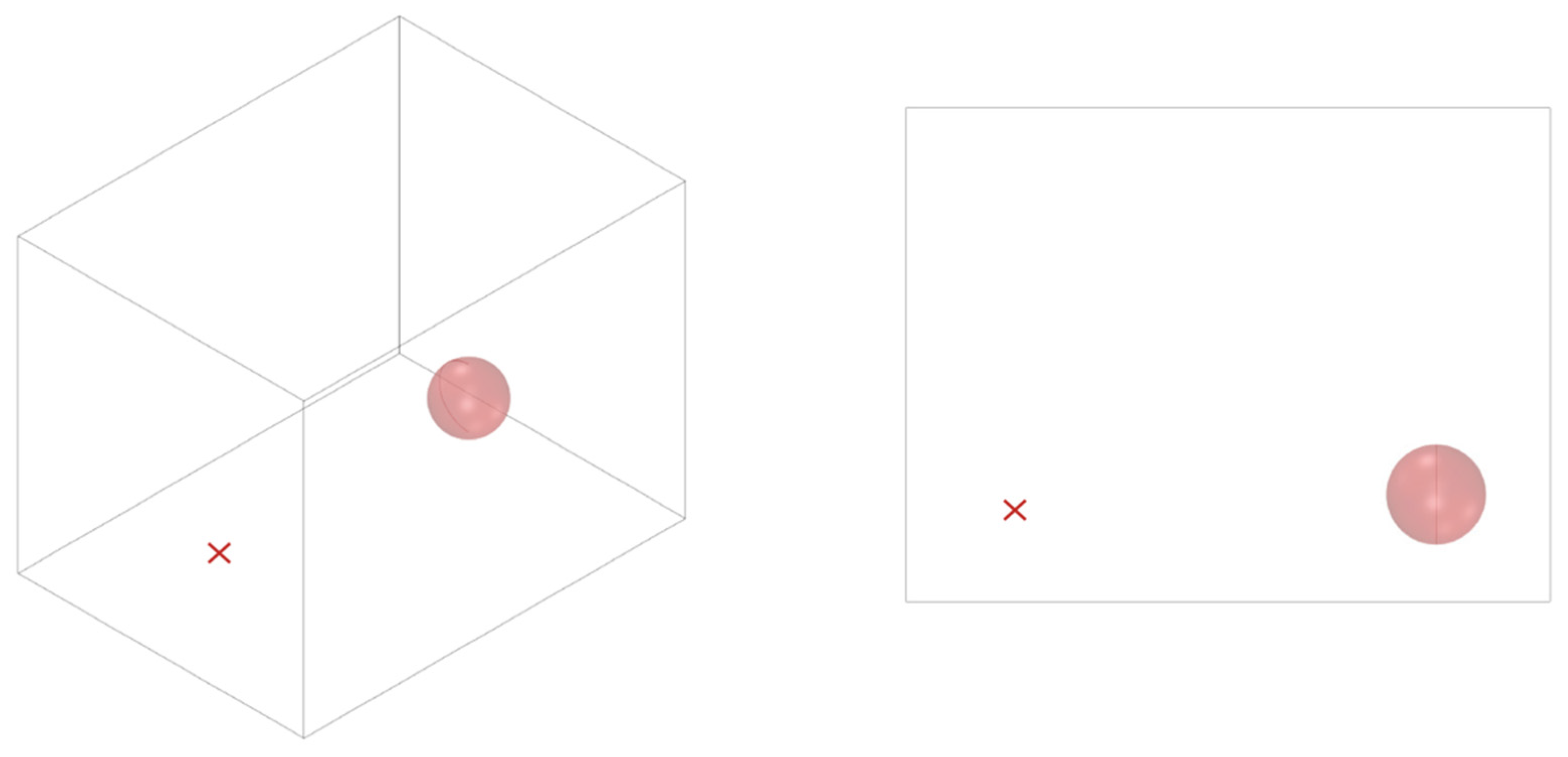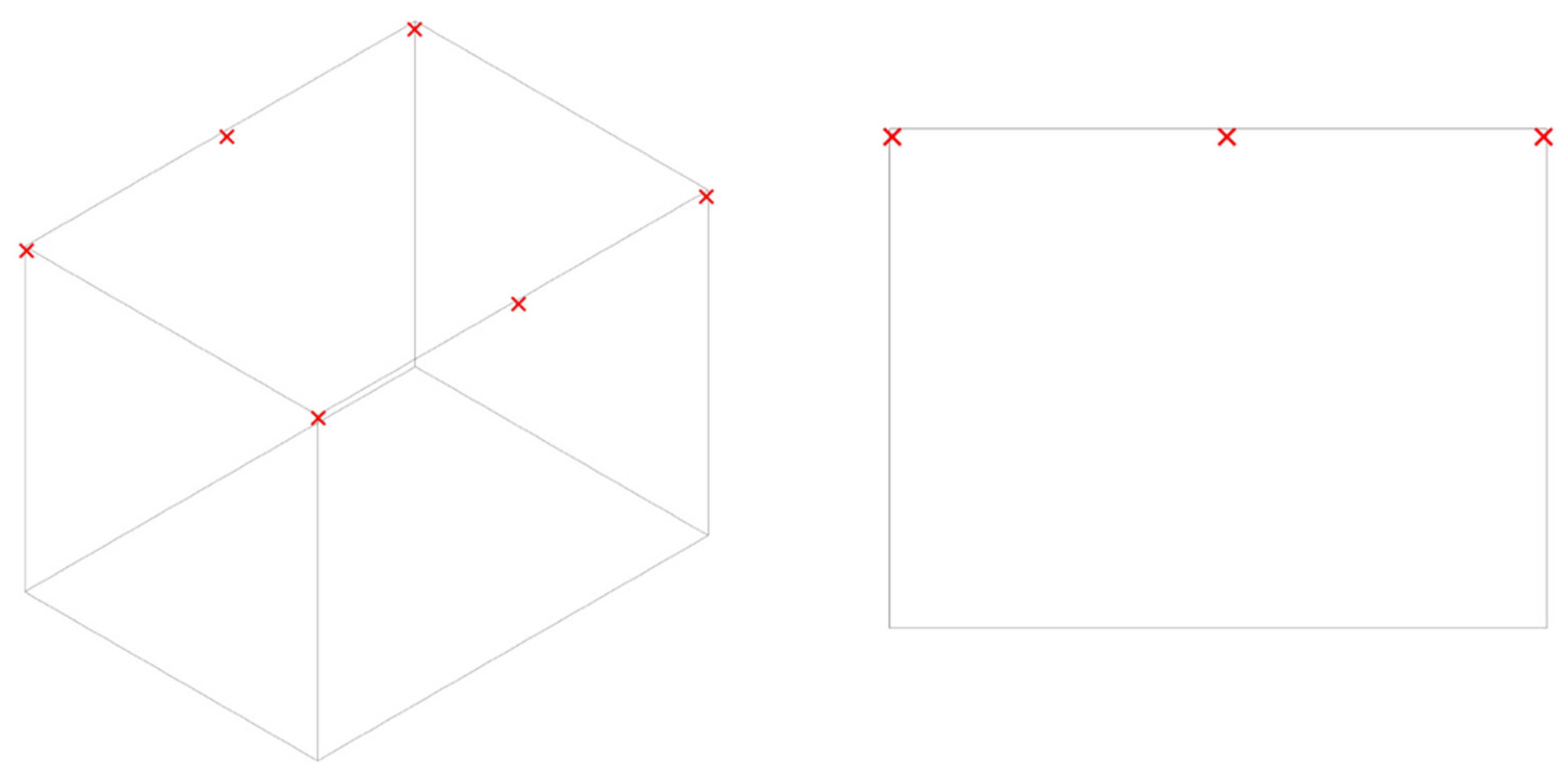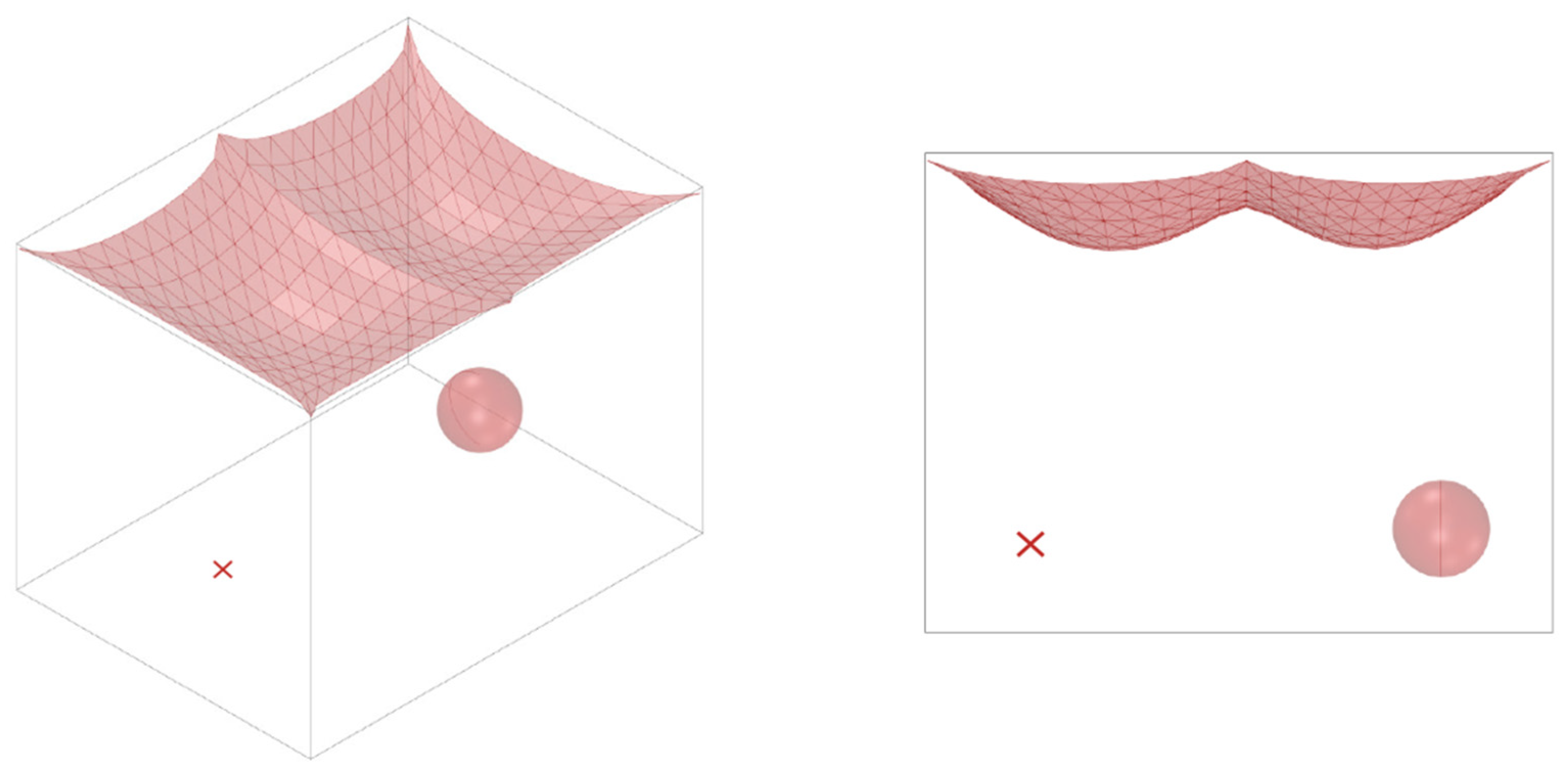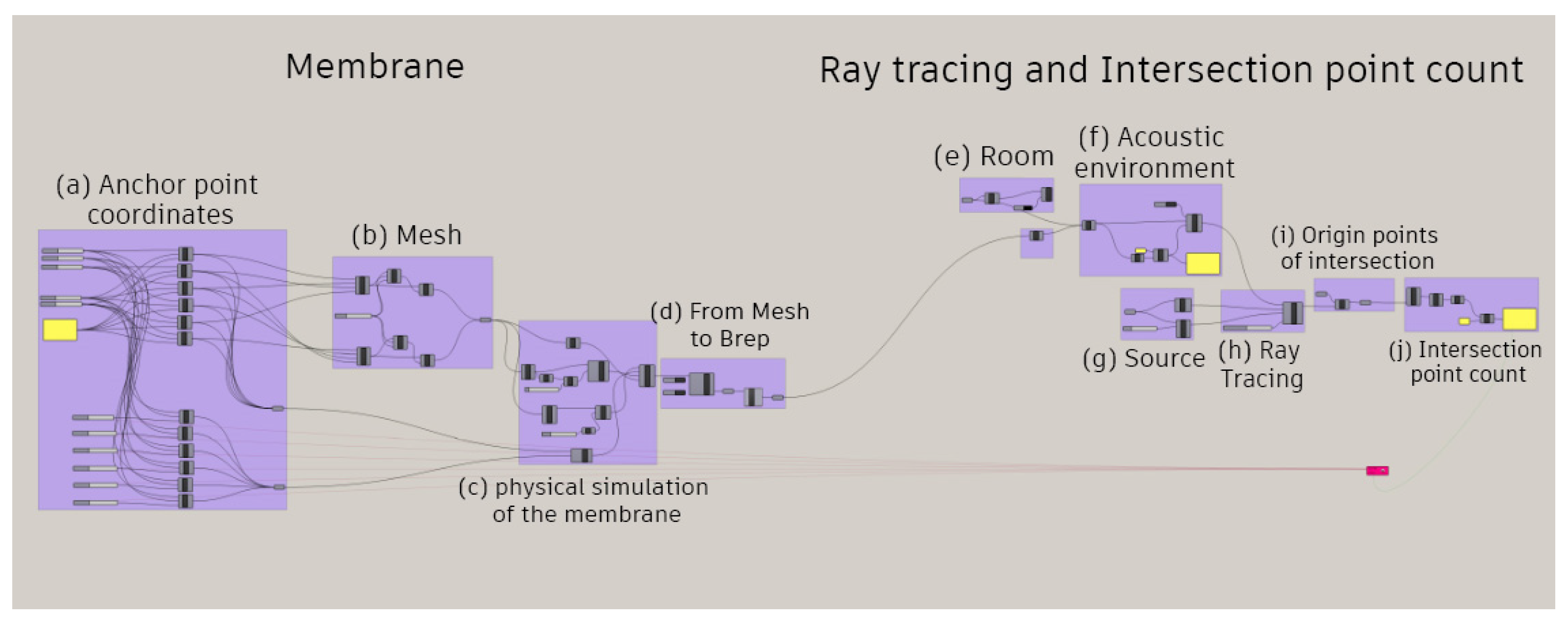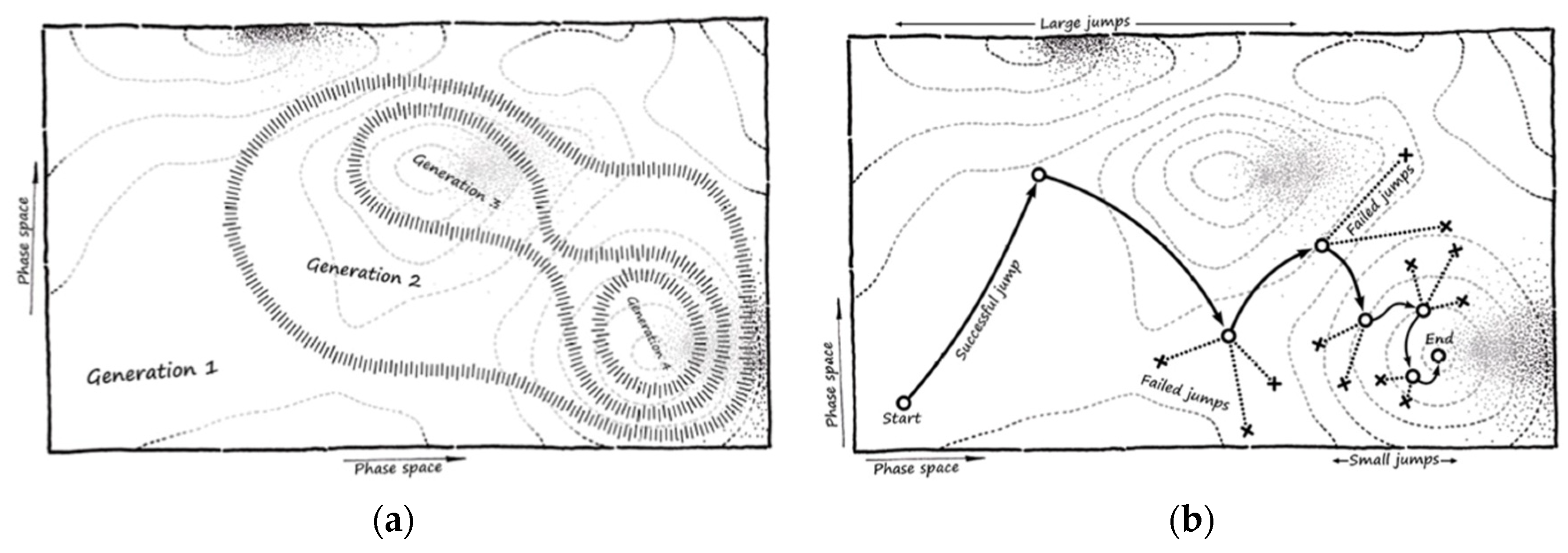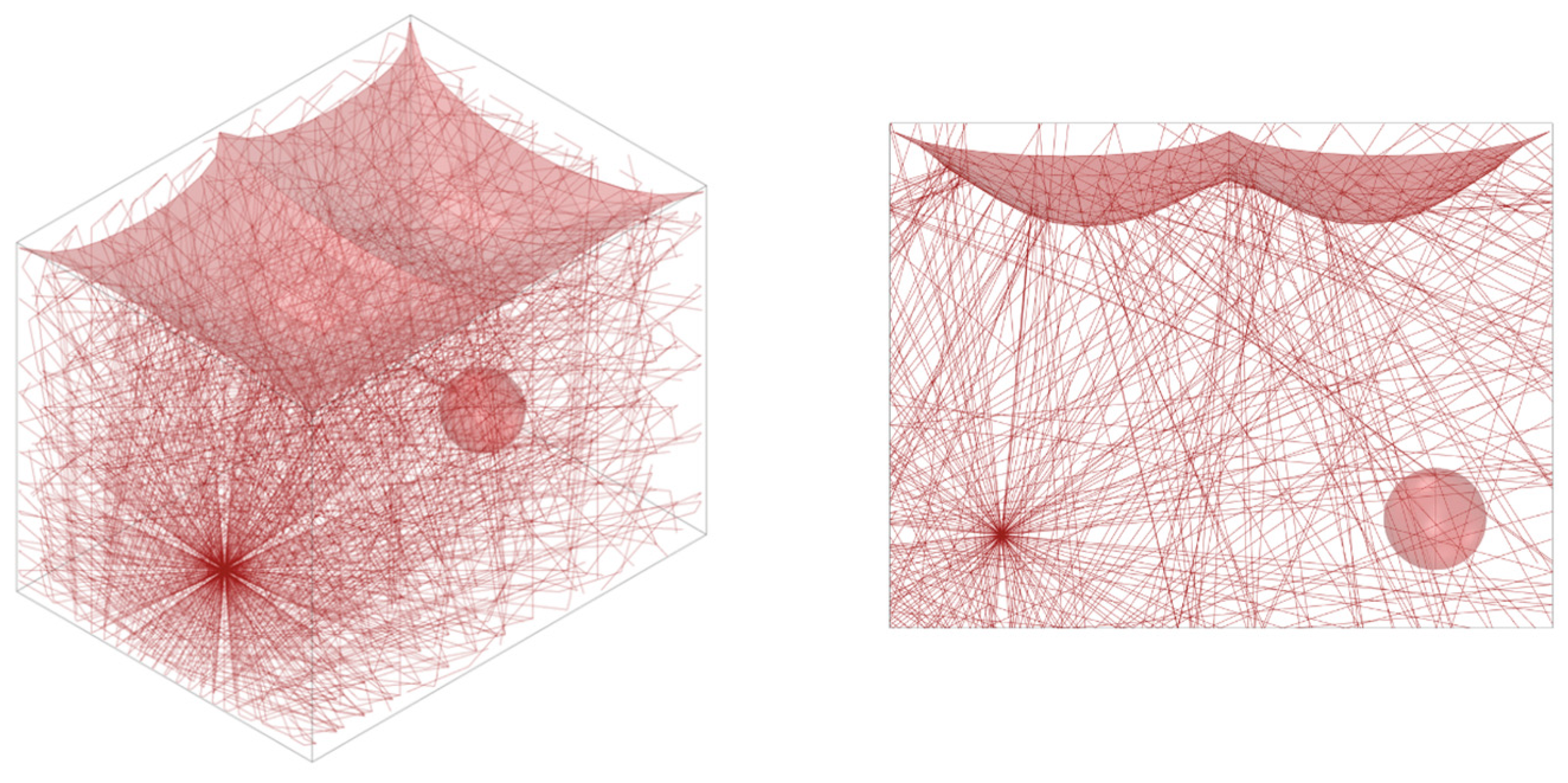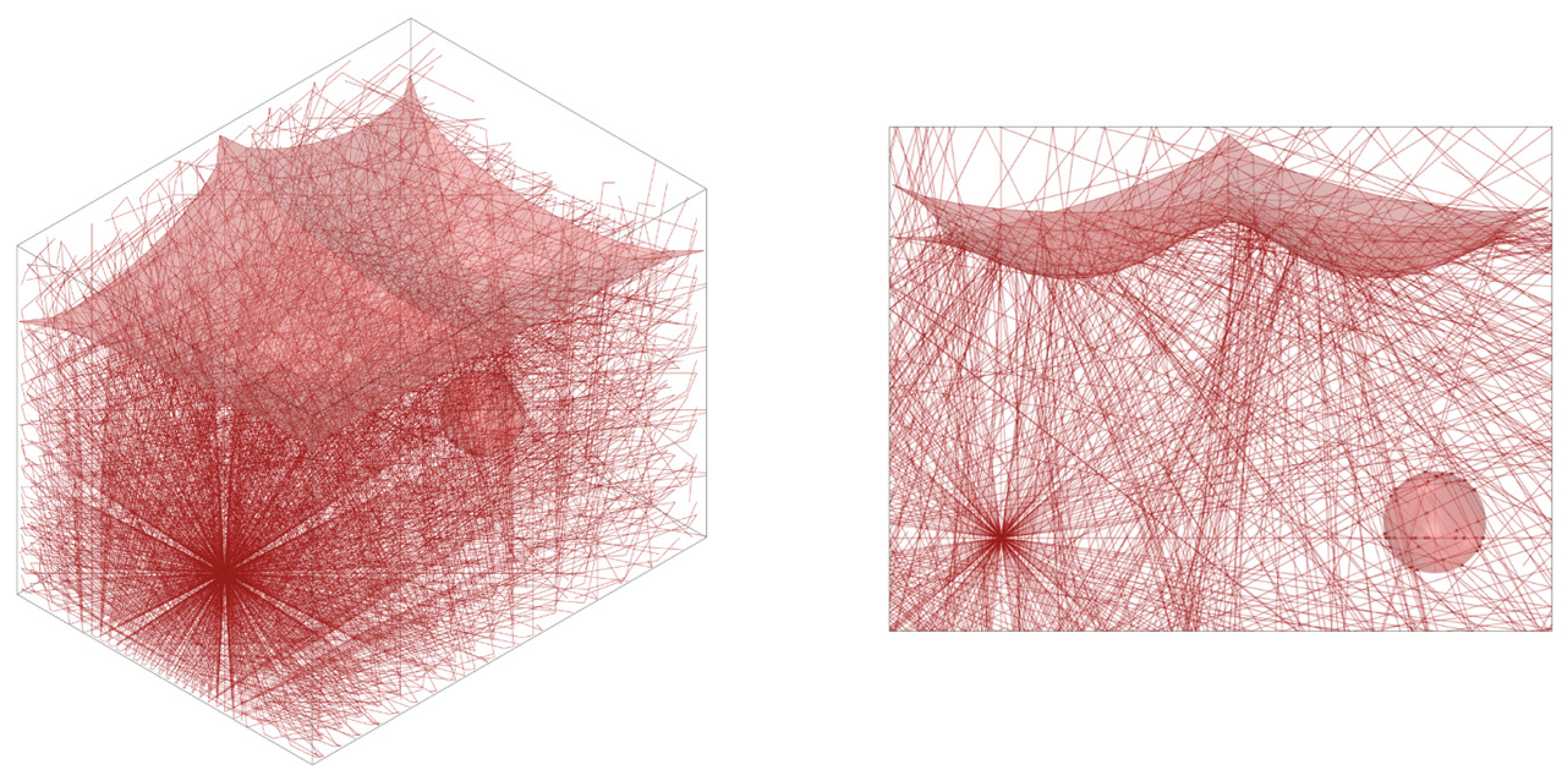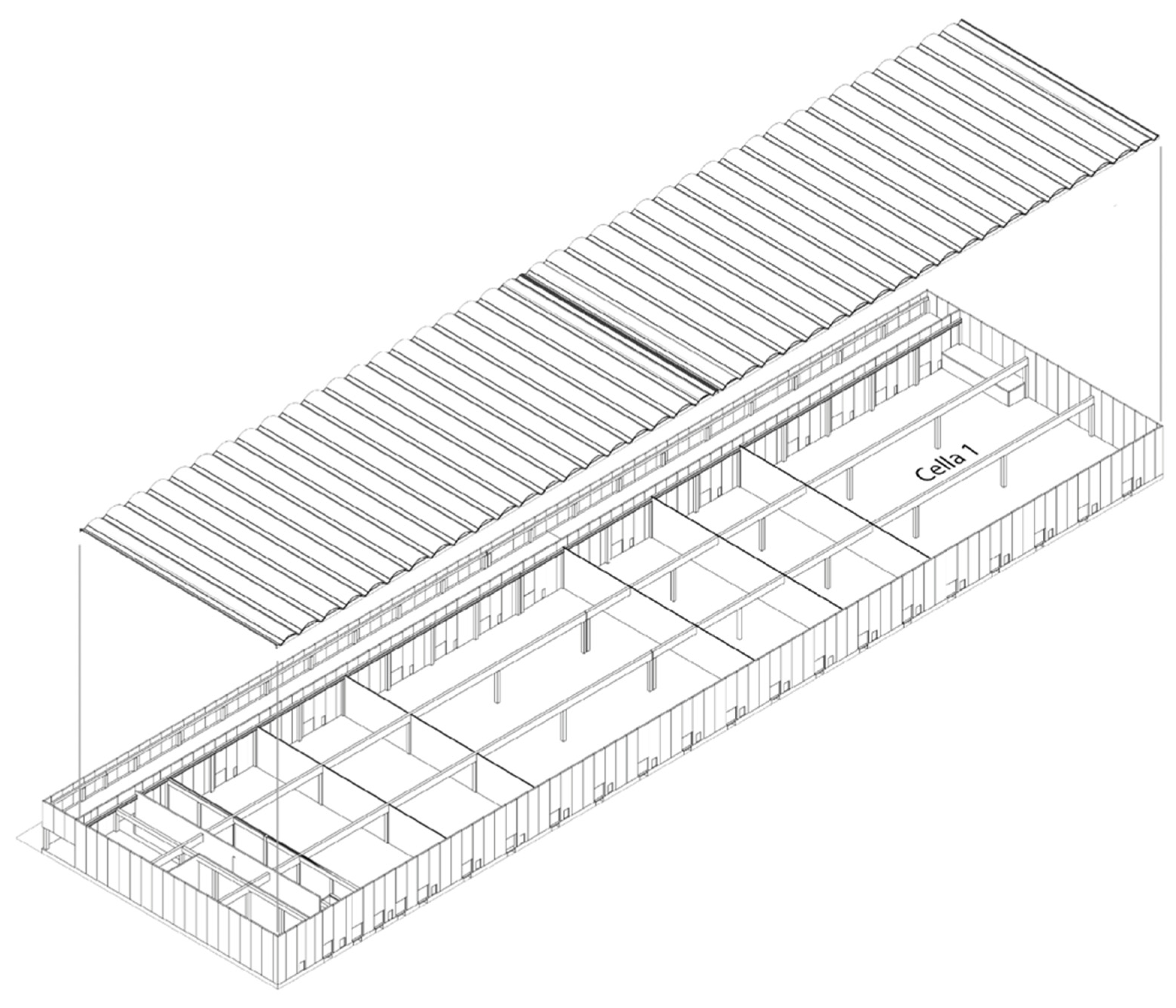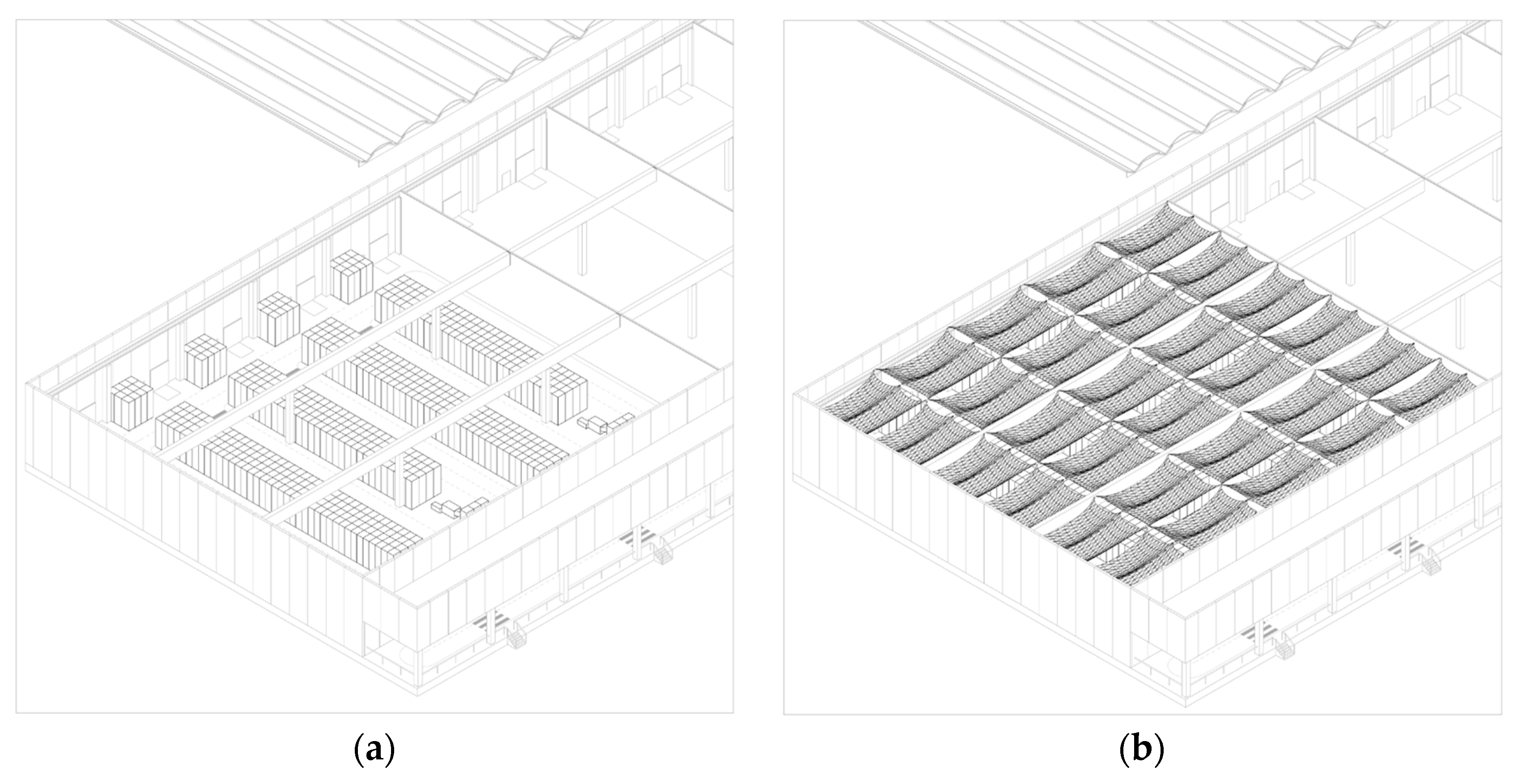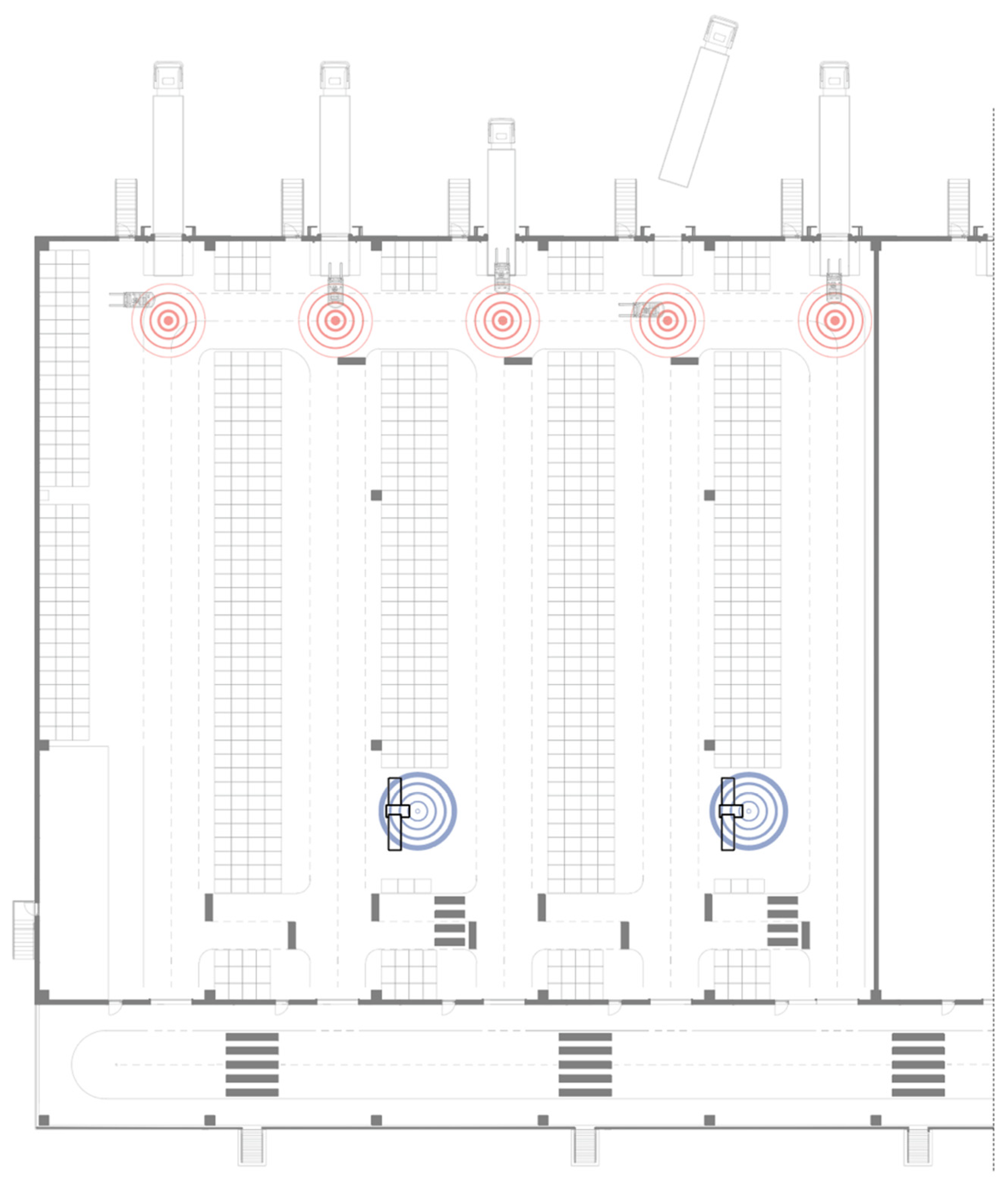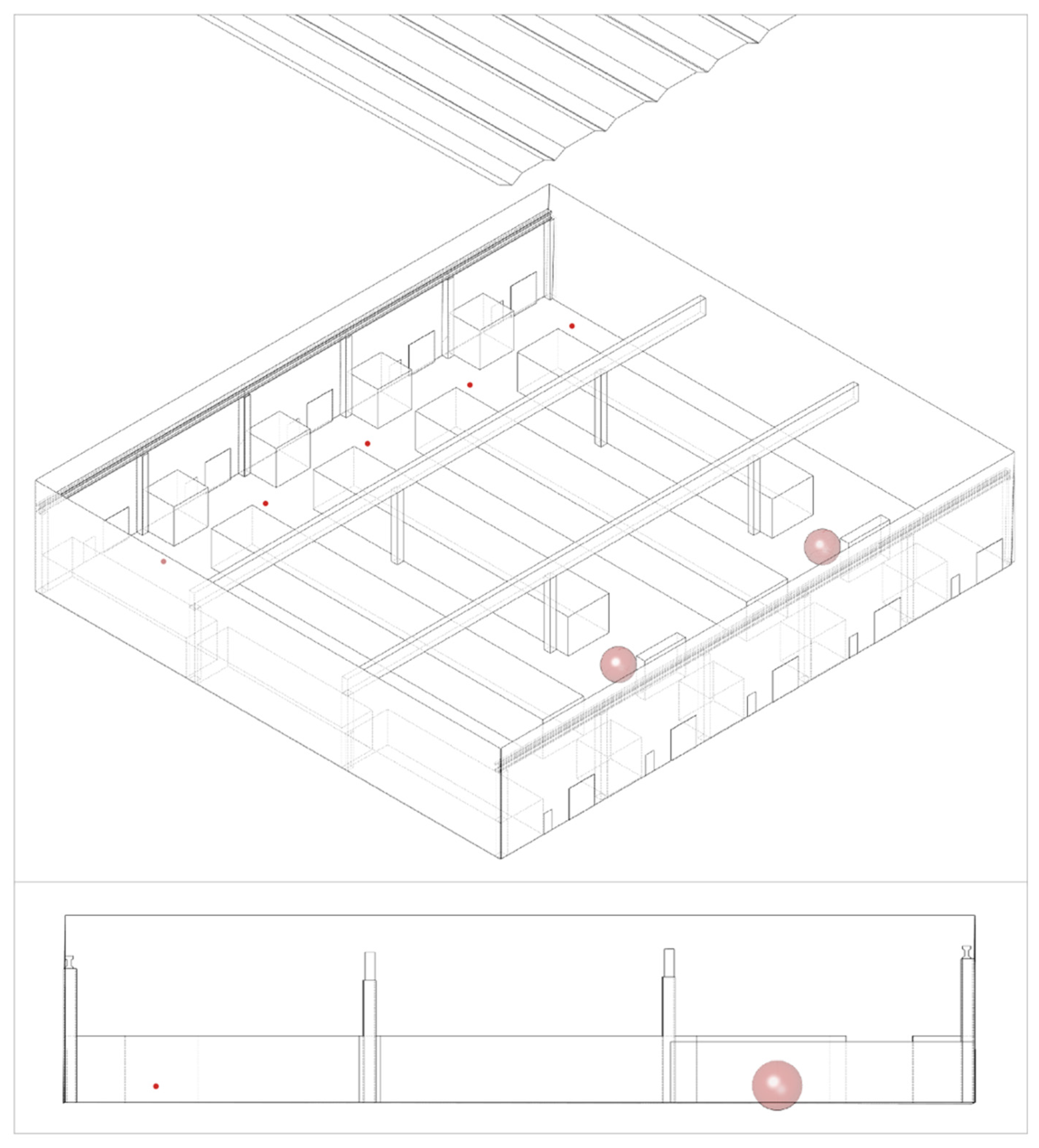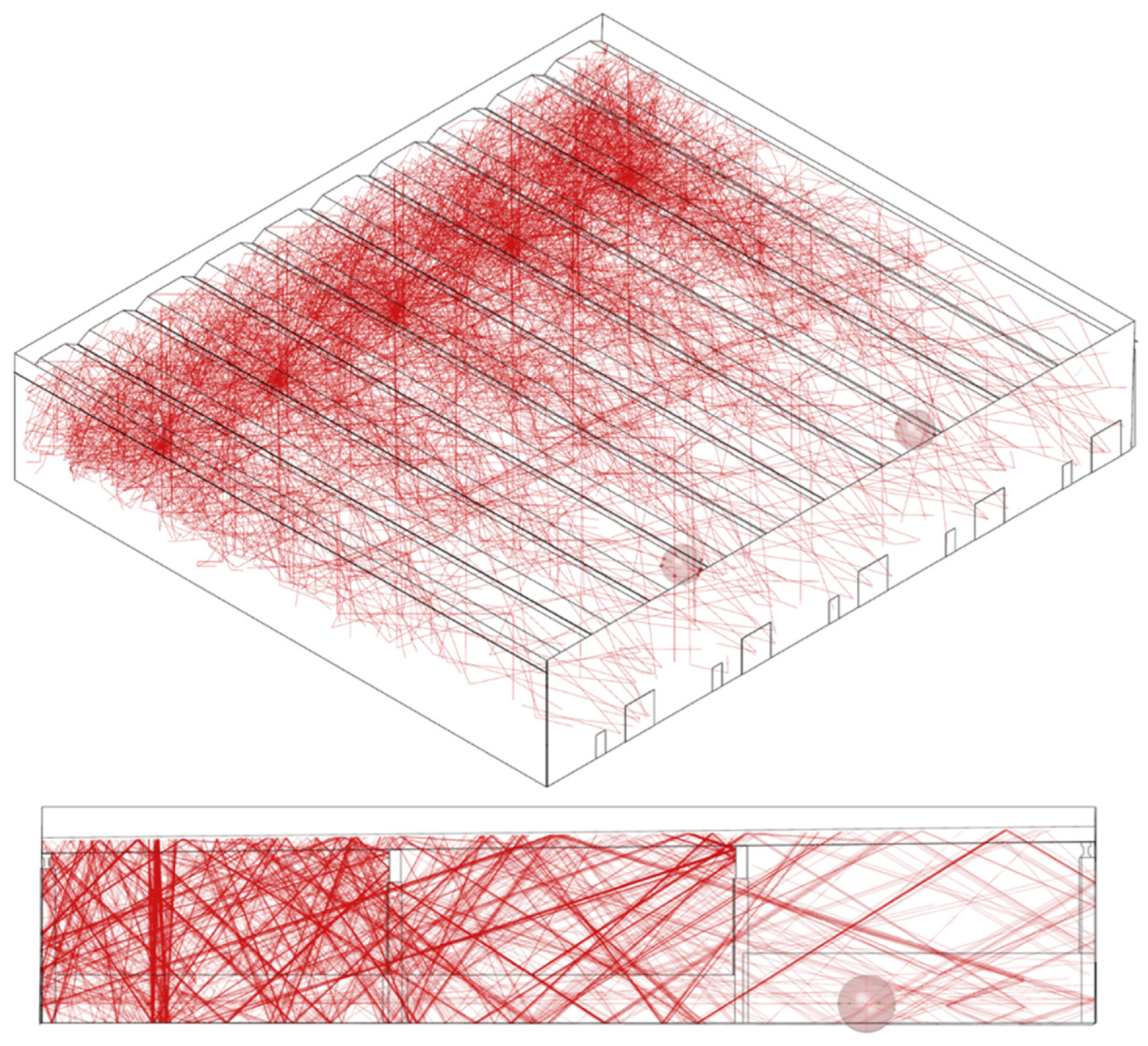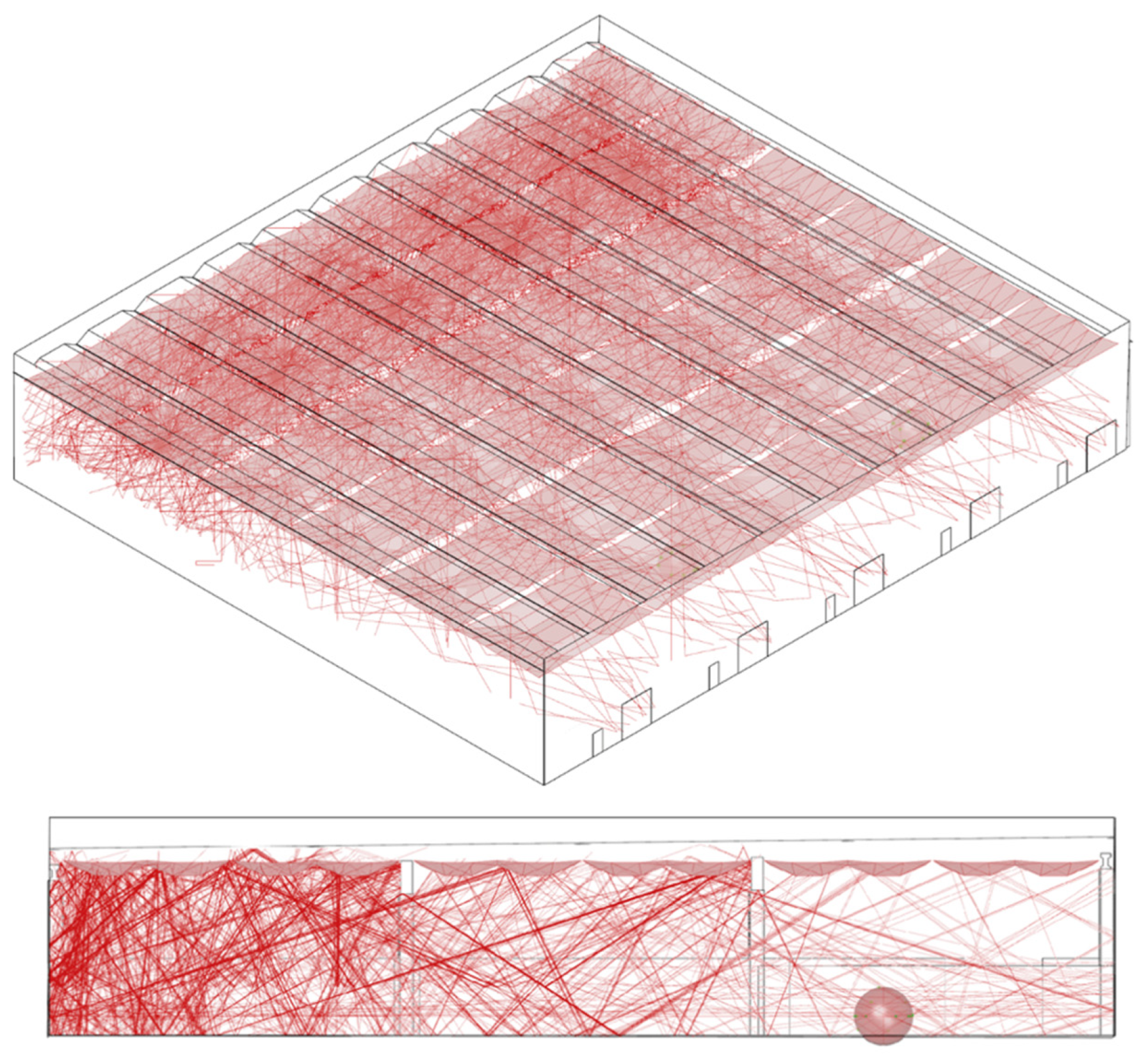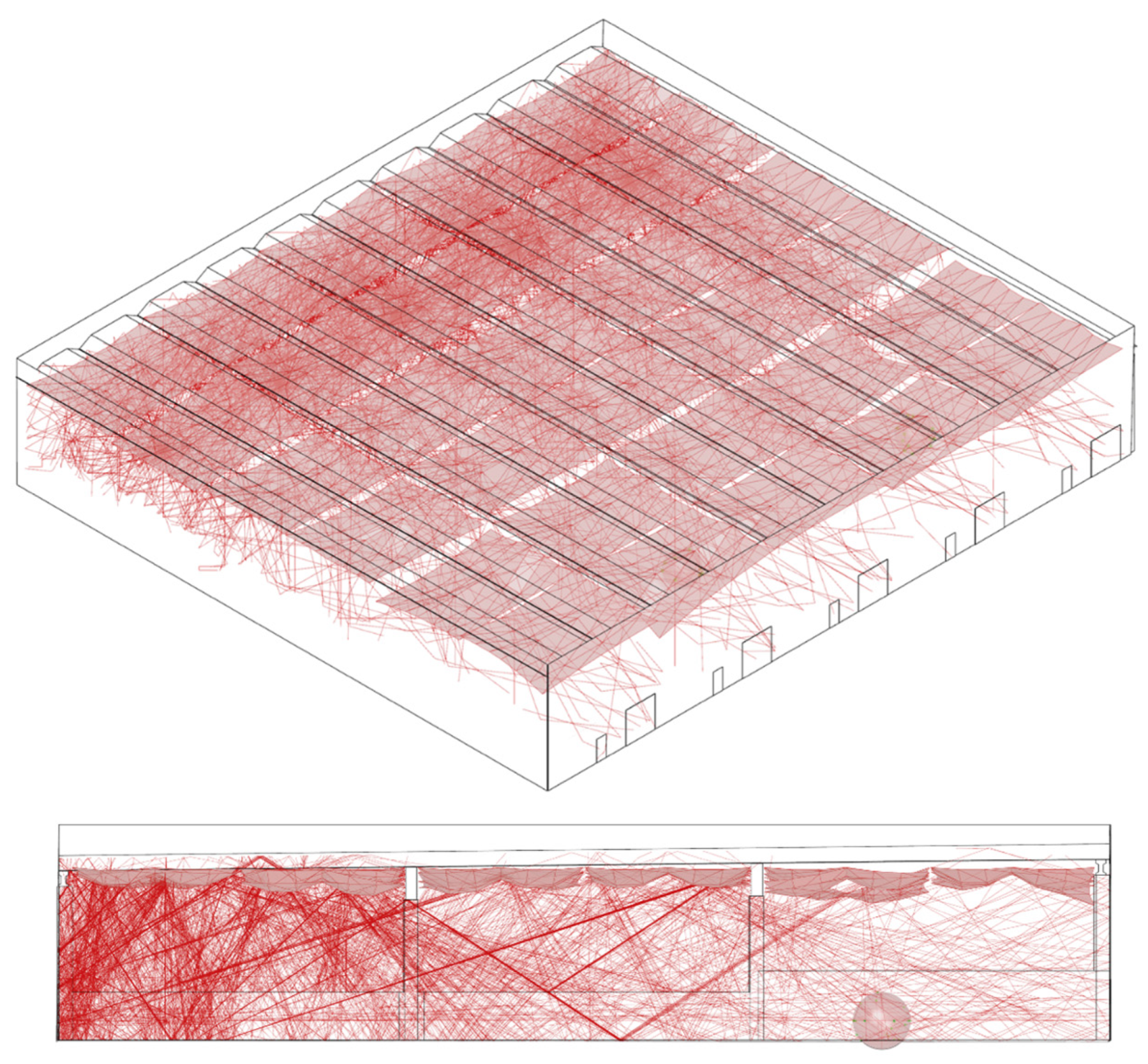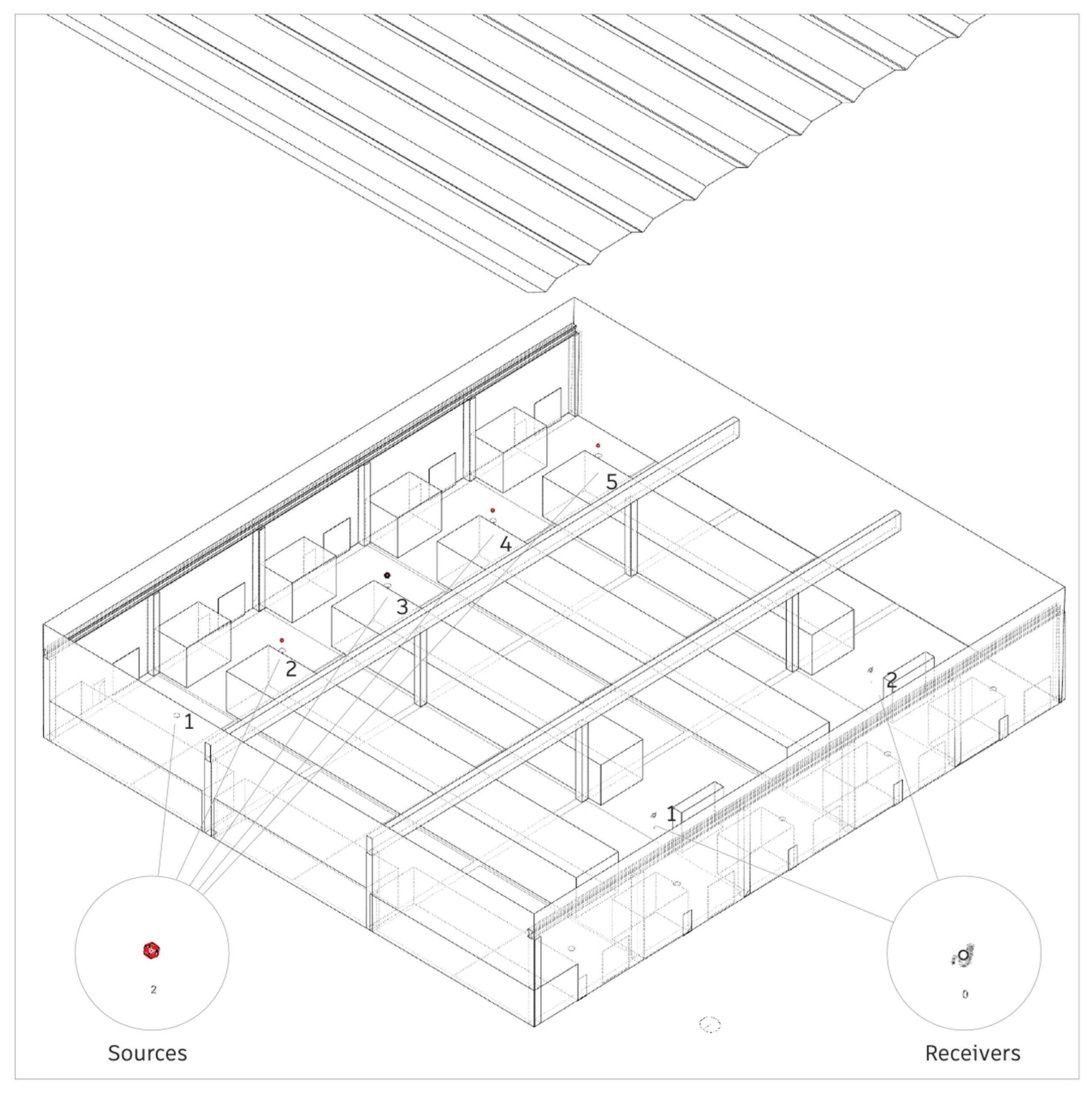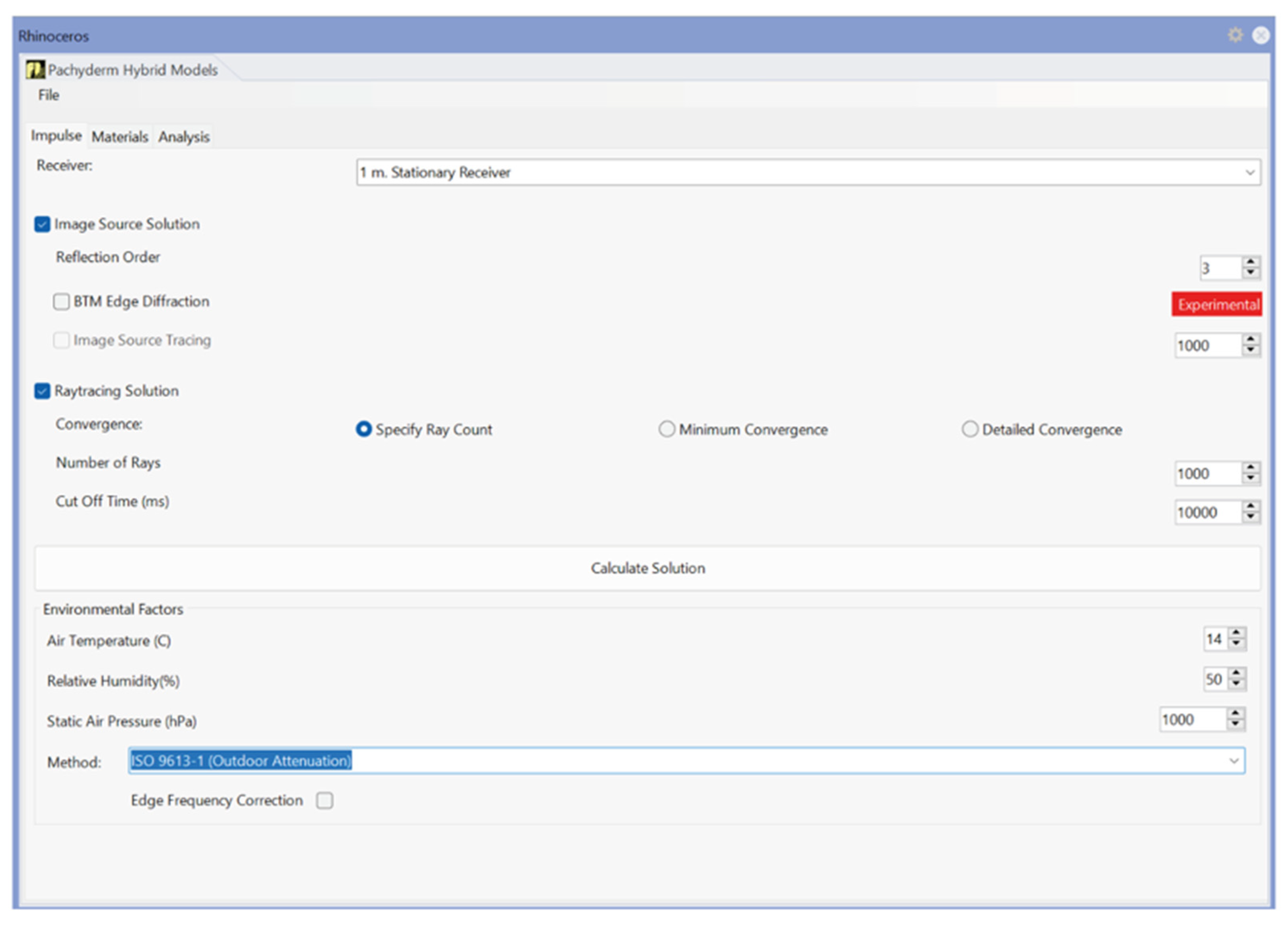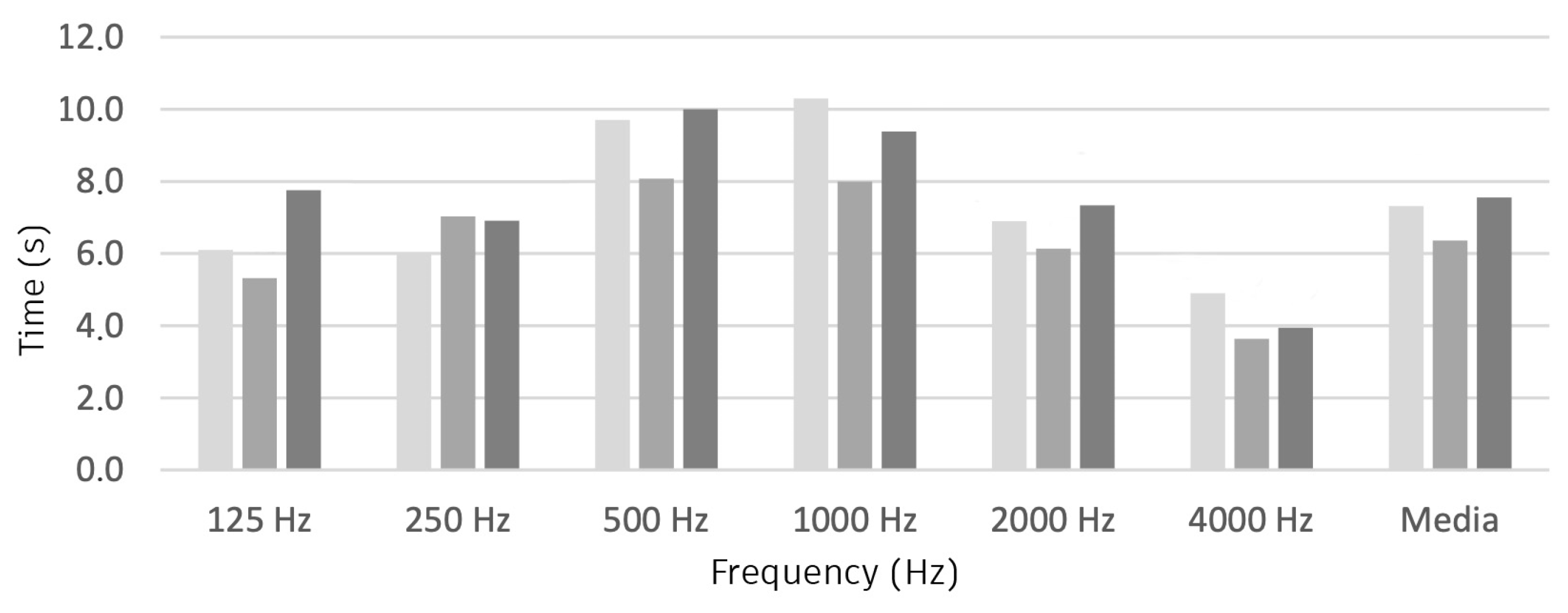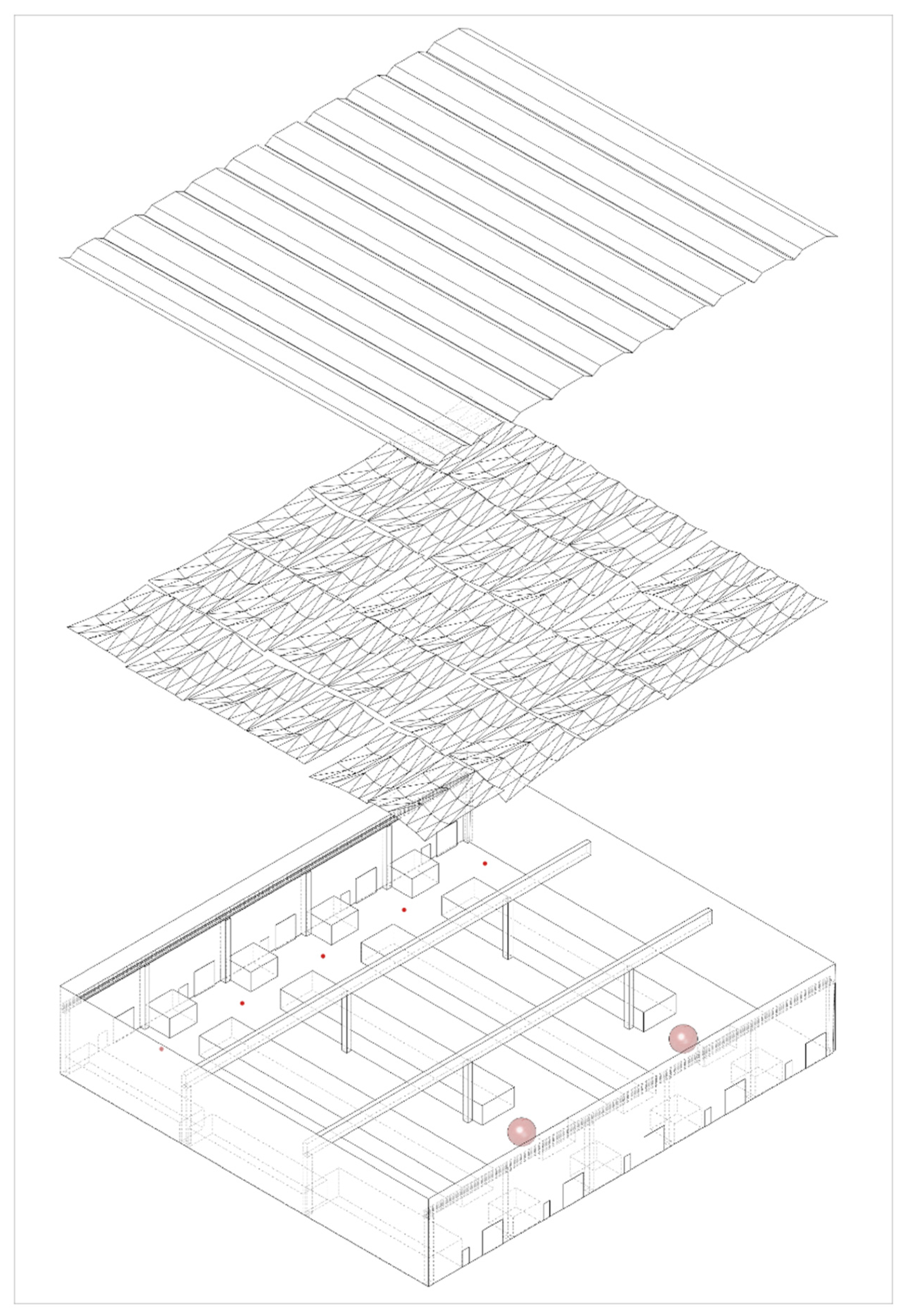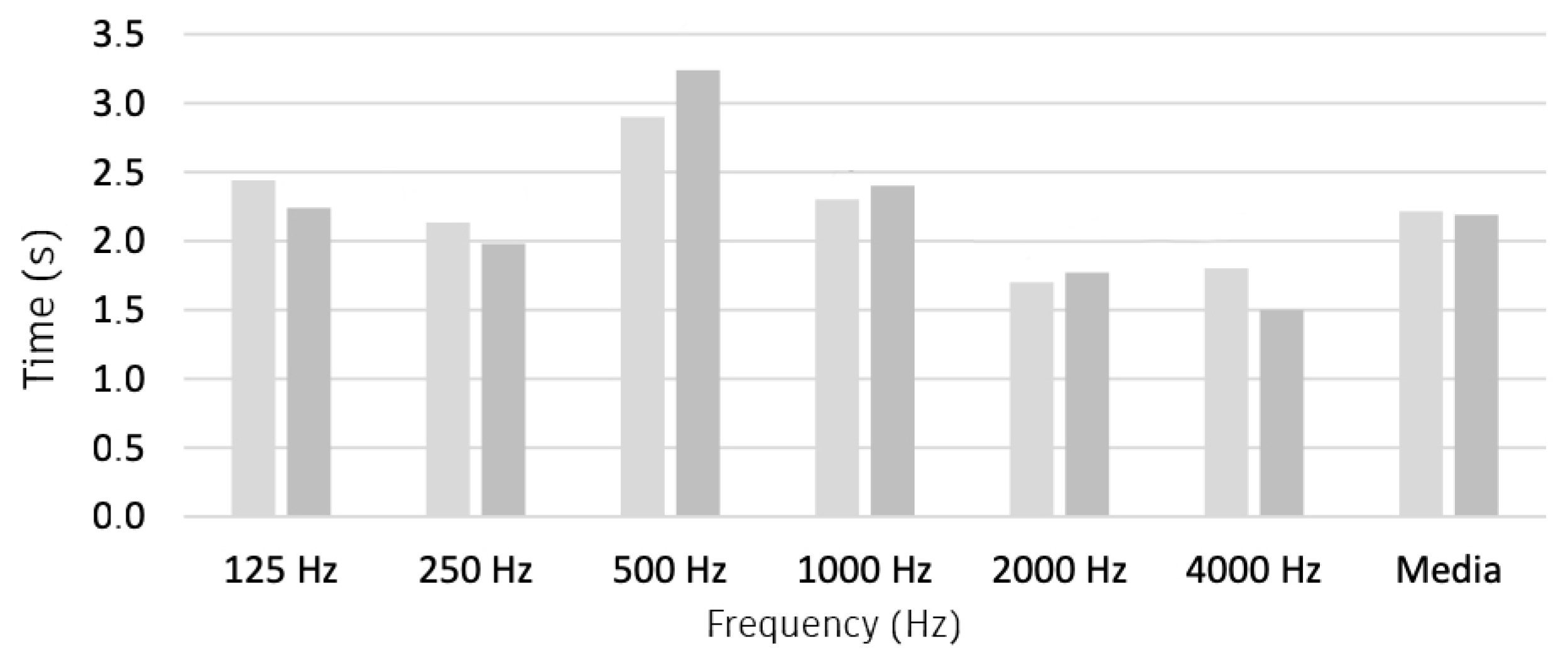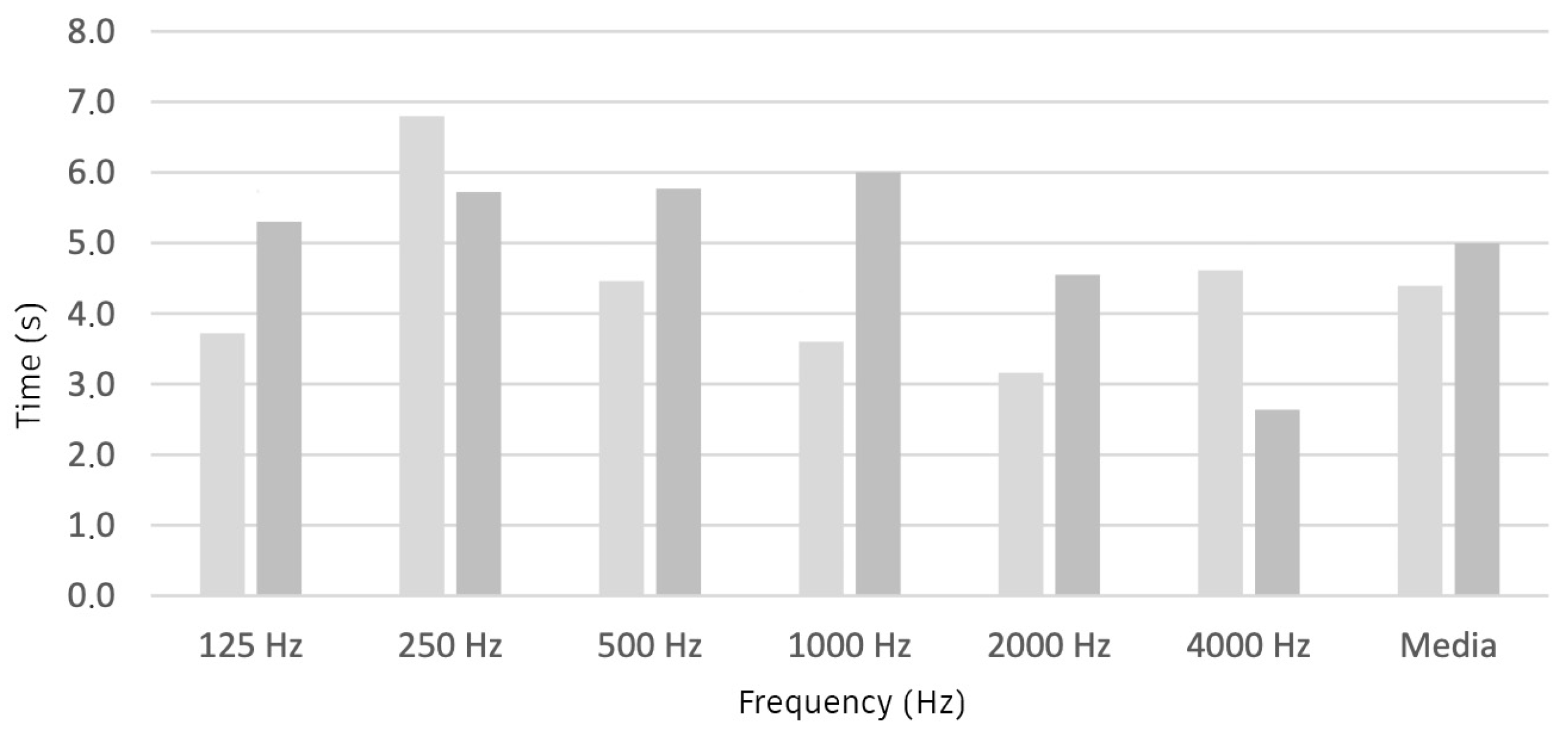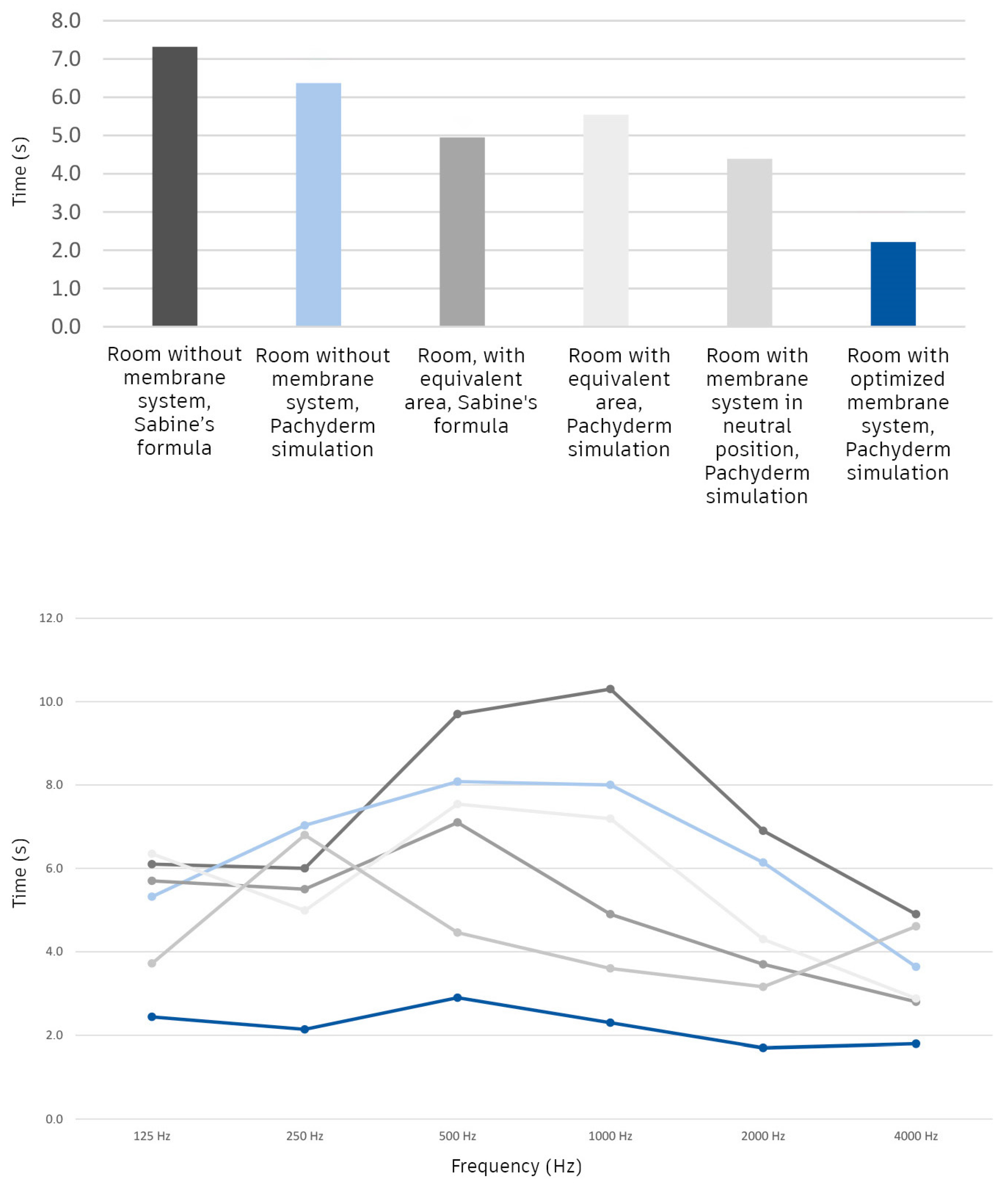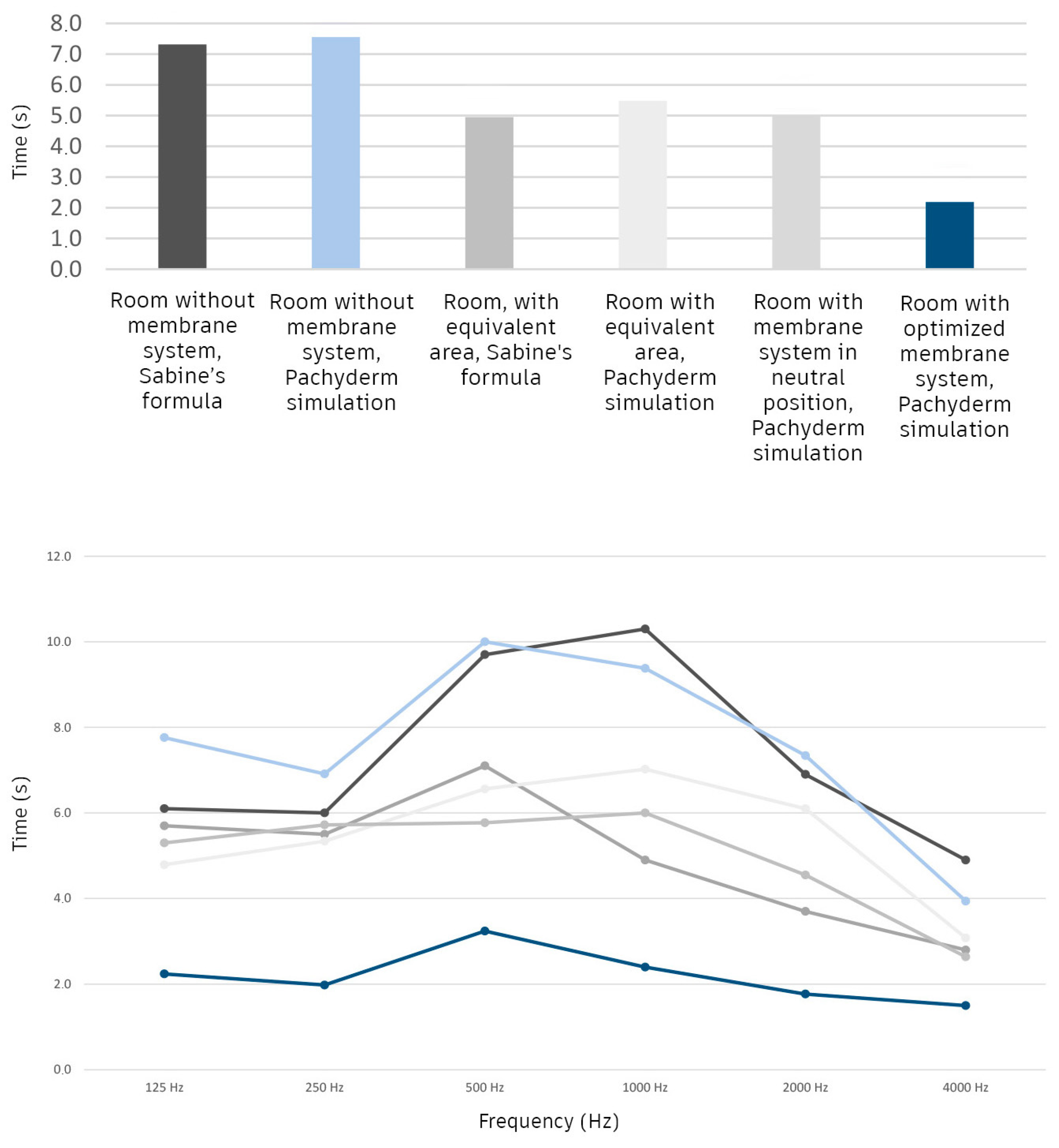2.1. Physical Membranes Factors
The membrane decommissioning process seems to be an insurmountable problem. The difficult recycling, the harmful and dangerous disposal for the environment and the very limited reuse opportunities limit the research radius for improving the end-of-life phase of the textile membranes [
1]. Acoustics tries to find a solution to deal with the problem. This research concerns the attempt to reuse abandoned membranes as acoustic diffusers for noise control in large environments. The membranes are suspended with a hooking system that allows for the adjustment of the heights of the surfaces, modifying the angle of incidence of the sound waves and diffusing and redirecting them into the environment. The height and, consequently, the curvature of the edges of the fabric change the overall geometry. With suitable solutions, the discarded membranes, as a second use, can be transformed into surfaces that control sound reflections, such as adjustable acoustic diffusers, as shown in
Figure 1.
Comparing the reused membrane diffuser with the currently most widespread systems is useful for understanding the potential of this technology. The membranes are designed to fit into acoustic correction systems, those installed after the construction of a building with the aim of remedying acoustic problems that arose in the advanced design phase or even after the completion of the construction. It means thinking of a system that integrates as much as possible but that does not interfere with the activities carried out within it. This is a complex operation that the designer must take into strong consideration, especially since the membranes are reused elements and therefore not specifically designed for this environment [
2]. The visible textile system may not be aesthetically suitable for environments with high requirements for design integration. On the other hand, the membranes have very interesting characteristics that could encourage their experimentation and their architectural integration.
The membranes’ materials vary and could change according to the design requirements [
3]. They have different physical characteristics and, to be reused, physical factors as well as aesthetic factors must be considered [
4]. Indeed, the membranes are composed of various materials and different layers, which give a different weight, density and resistance according to the required needs. These specifications can influence the acoustic performance of the membranes, especially in sound absorption. The higher the sound absorption index of the fabric is, the greater the reverberation time reduction performance obtained. The sound absorption coefficient of a material varies according to its density and porosity. In general, membranes, including those suitable for reuse, have a relatively low average sound absorption coefficient, which is around 0.2, as shown in
Table 1 and found in other studies dedicated to the measurements of technical textile proprieties [
5].
Another very important parameter to consider is the weight of the membranes [
7]. The membrane relies on its own shape to reflect and diffuse sound so the fabric must resist sound waves. With some theoretical simplifications, the following is stated: if the weight of the membrane is high, then the energy of the sound waves passes with difficulty through the fabric and most of it is reflected. In other words, the higher the weight of the membrane, the more difficult it is for the vibrations diffused in the air to pass through the material; sound waves are reflected rather than transmitted. This factor is the most critical for the efficiency of the acoustic control and sound wave redirection system. The membranes, made up of layers of different natures and materials joined together with glues or resins, are often extremely flexible, and therefore easily distorted by vibrations. It is necessary to select the right fabric in order not to allow this phenomenon to occur and so that the membranes oppose resistance to the sound energy that hits them. At the theoretical and experimental level, this research only partially takes into account this phenomenon because the simulation of sound using software is very complex and difficult to control. During the simulation, the surfaces that symbolize the membranes are considered planes that reflect the sound waves, considering the sound-absorbing and diffusing properties of the material, but not the phenomenon of the propagation of vibrations through and beyond the membrane.
2.2. Design Process: Form-Finding
In order to verify the response of the reused membranes as an acoustic instrument, the design process involves many analysis tools and simulation models. Their use is essential as it allows the implementation of an acoustic intervention in real environments that are reconstructed in a virtual environment, with the advantage of acting ante operam, even before the buildings are built. Here are the two main reasons for the defined research methodology. Firstly, this process allows plausible measurements in a virtual environment without having to intervene with tests or analyzes in the real environment. Secondly, the management of the complexity of reality by working on suitably simplified virtual models is possible thanks to simulations; it is well known that the analyses of some environments are very complex, especially that of very large volumes.
The simulation in the virtual environment of the behavior of the textile membrane reused as an acoustic instrument is shown as follows. Two degrees of simulation have been prepared. The first concerns the modification of the shape, starting from a simple simulation in a small environment aiming to verify the “Form-finding” process. The second, on the other hand, translates the simulation into a very large existing environment, verifying the acoustic behavior of the membranes [
8].
The shape of the membranes changes according to some parameters in order to interact with the context. The shape of the membrane surfaces is determined through a Form-finding process, which allows for optimizing the shape of the fabric to obtain the best response to solve the acoustic problem [
9]. In the architectural field, the Form-finding process has been applied for some time as it is extremely useful for obtaining an objective answer to a problem concerning the shape of a specific architectural element [
10]. Form-finding is the simulation design process which, given the shape of the space, the position of the acoustic source, the position of the receiver and the physical properties of the membranes as the input, returns, as the output, the shape of the membrane. Depending on the request, the adaptability of this shape allows us to maximize or minimize the amount of rays which are hitting the receiver [
11,
12,
13]. In fact, within the simulation, sound has been simplified into a variable number of rays which are diffused into the environment starting from the emitter. Through an algorithm, the membrane is modeled in order to change the angle of incidence of the rays and move them away or bring them closer to the sphere (basically the receiver).
The geometry of the membranes is not univocal for any space but is extremely dependent on the characteristics of the environment, their arrangement in internal spaces, the position of the sources and, above all, the position of the listeners. Consequently, this means that the shape of each surface varies in relation to the variation of these parameters. The Form-finding process is implemented through various simulation software. First Rhinoceros3D version 7.29, a three-dimensional modeling software that allows for the creation of the space for simulating the acoustic field. The next step is the creation of the simulation space, including building surfaces and three-dimensional elements that interact with the acoustic simulation. The current simulation concerns the analysis of a fictitious environment with the aim of highlighting the phases which are then actually carried out for the large-scale environment exposed in the following section of the article. To simplify the problem as much as possible, consider a room with a base of 9 × 12 m and a height of 7 m, as shown in
Figure 2. It is important that the simulation space is closed and well-confined, without cracks or holes from which the sound could come out and preclude the fidelity of the result. In this environment it is necessary to indicate two points to represent a source and a receiver. Even if the environment is small, it is assumed that the source emits sound uniformly in all directions and the receiver is a three-dimensional shape which is intersected by the rays.
This demonstration helps us to fully understand the simulation procedure. A step further is to proceed with the complete large-scale simulation. It is important to understand that, in a room of this size, a Finite Element Method (FEM) or Boundary Element Method (BEM) would probably be used. FEM and BEM are mathematical methods of calculation and acoustic prediction suitable for small objects or environments. These methods can achieve high accuracy thanks to the rationalization and discretization of the elements they analyze. Their precision hinders their application in large environments and for large objects where the size of the analysis does not require such detailed processing, preferring a faster and broader approach instead [
14,
15]. Since the main interest of the acoustics application for the reused membranes is a very large room, a geometric simulation of the acoustic phenomenon was used to better understand the design process. In this way, the shape variation of the membrane due to the Form-finding procedure is even more evident.
The suspended textile surface that completely covers the ceiling of the fictitious room is then added. Because it is composed of textile materials, it was decided to anchor the membrane at six points (
Figure 3) to be able to intervene more effectively on the shape of the membrane without compromising the resistance of the material. Since the fabric models itself thanks to its own weight, the simulation considers the force of gravity acting on the membrane. If there were fewer points, the robustness and modifiability of the system would be compromised, while if there were more, the complexity of the optimization calculation would enormously increase without obtaining better results from an acoustic point of view. The use of the program Grasshopper, as part of the software Rhinoceros 3D version 7, allows for the creation of complex shapes otherwise impossible to simulate [
16]. To give the surfaces their real behavior it is necessary to use a Grasshopper plug-in called Kangaroo. It is therefore possible to subject the surfaces to the force of gravity and, in the meantime, constrain them at some points, also simulating the tension to which the membrane is subjected (
Figure 4). By varying the height of the points, the shape of the surface changes, respecting the laws of physics, as if the edges of the membrane were raised or lowered.
It is now necessary to create the acoustic field by simulating the behavior of the sound, making it interact both with the environment and with the surfaces that simulate the suspended membrane. This is certainly one of the most complex phases because the calculation algorithm is very heavy. The behavior of sound can be simplified in the form of rays which, interacting with the boundary environment, are reflected and diffused in space. The large number of rays, the complex surfaces and the high number of reflections cause an increase in the calculation time of the simulation. For this reason, in order to make the simulation faster without precluding its acceptability, it is possible to act by decreasing the number of beams and, if possible, the number of sound sources. The more rays considered, the greater the precision of the calculation achieved; therefore, it is necessary to find a fair compromise between the two parameters.
All acoustic operations are simulated thanks to another Grasshopper Plug-in called Pachyderm [
17]. This allows certain functions to confer to the entities present in the space. In this case, the point represents the sound source, the environment and the textile surfaces are the border surfaces, and the sphere is the receiving space. The rays originate from the sources according to the procedure of the deterministic sphere: the sphere is simplified and divided into many polygons [
18]. The direction of the acoustic rays is determined by the line passing through one of the vertices of a polygon and the center of the sphere. In this way the rays spread uniformly in all directions and encounter the geometries of the environment (
Figure 5).
To analyze the receiving area from the point of view of reverberation, an intuitive procedure was conceived, which is then evaluated with an algorithm composed of a series of commands by which Pachyderm can return the reverberation time at a point, considering the environment in which the receiver is located. The algorithm is a series of graphic commands, capable of generating complex three-dimensional mathematics through the definition of a node diagram. The procedure is like the Reflection Free Zone phenomenon, a particular situation in which the reverberated sound, thanks to some devices regarding reflections and absorption, is excluded from a given area. In other words, the calculation tries to isolate a part of a room from reflections, receiving only the direct sound and not the reverberated one. The textile membrane is modeled with a shape, thanks to which the reflections are not directed towards the receiving area, leaving it free from a good fraction of sound waves. The reverberation time decreases as the receiving area is excluded from a part of the rays that act to create a reverberated sound field.
An optimization process is required to obtain the right geometry of the textile membranes. The operation consists of acting on some parameters to find the best formal solution for the problem. In this case, the question concerns the shape of the suspended membranes to reflect the least number of sound waves towards the receiving area, modifying the length of the supports. The Grasshopper Plug-in that allows such an algorithm to run is called Galapagos. This procedure is called Multi Objective Optimization, as it acts on various parameters simultaneously in order to find the best possible result. The lengths of the supports that regulate the shape and the position of the membrane have infinite combinations, but the algorithm can identify the best one.
The Plug-in has two different optimization methods that are different from each other but acceptable for research purposes. The first method is called the Evolutionary Process (
Figure 6a) and consists of determining the best solution by comparing all possible combinations originating from the variables. It works by comparing solutions one by one and finally choosing the best one. Of the two processes, it is the more precise but also the one that requires the most time as it compares all the solutions. This means that having many variables in the system will make the algorithm very slow. The second method is called the Annealing Process (
Figure 6b) and works differently. This method works by trial and error, jumping from solution to solution until it gets to the best one. This procedure is much faster as it is not a question of verifying every combination but rather of happening on the best one. The process, however, is not as casual it might seem but the attempts become more and more precise as the procedure progresses [
19].
To better explain the two methods, here is an example of the mountain for which the Optimization Process must find the point on a map where the highest peak among those present is located. In the case of the Evolutionary Optimization Process, all the level curves are analyzed, proceeding slowly and excluding unsatisfactory solutions. In the case of the Annealing Optimization Process, the proceedings go on by leaps, which are shorter where the solution seems promising. If, by chance, an attempt results in a backwards leap, then it is excluded and it returns to the previous leap, attempting this an infinite number of times until it finds the leap that leads to the top of the mountain. For research, both methods work great but the first is much slower. By slightly sacrificing the precision of the process, it is decided to opt for the faster execution to reduce the calculation times without compromising the precision of the analysis.
Knowing the variables, that is, the height of the membrane supports, which in this case have a range of 170 cm, and knowing the output of the algorithm, that is, the shape of the textile surfaces, it is necessary to understand which parameter to search for in order to find the right solution. Thanks to the “Acoustic Manual” by Renato Spagnolo, which deepens the acoustic theory by referring to the simplification of sound by means of acoustic rays and to the simplification of the receiver by means of a sphere that surrounds it, the synergy between the two factors determines a new valid parameter on which the simulation can intervene: the interaction between the acoustic beams and the sphere [
20]. In this way, a value is obtained which symbolizes the parameter on which the algorithm can act. The process finds the shape of the membrane for which it is verified that the receiving area is hit by the least number of acoustic rays in order to isolate it as much as possible from the reflected waves.
The effect of the Form-finding process is highlighted in
Figure 7,
Figure 8 and
Figure 9. By acting on the height of the anchoring points of the membrane, it is possible to find the shape that best modifies the reflections of the rays and moves them further away from the receiver. Once the algorithm has been performed and the best possible surface has been found, the number of rays that intersect the receiving area is lower than in the environment without the membrane. The test highlights the limited effectiveness of the system if it consists of a single surface in a very small room. The objective of this brief simulation, however, as already mentioned, is not to demonstrate the system’s ability to attenuate reverberation but rather to demonstrate how the membrane adapts to the surrounding conditions, showing the procedure of the Form-finding.
In the next paragraph, the same procedure is used but in a realistic environment with probable boundary conditions and with much larger dimensions and entities, describing the real acoustic capacities of many membranes in a hypothetical and plausible area of use.
2.3. Form-Finding, Simulation in Big Spaces: “Fruit and Vegetable Logistics Platform”
To test the reused membranes as a tool for acoustic control, a simulation path was implemented for the acoustic analysis and simulation of the Milanese Fruit and Vegetable Logistics Platform (PLO) (
Figure 10) during the construction phases carried out in 2022, resulting in an
ante operam development of the analyses. It is a very large industrial shed that houses the goods storage and handling services. The building is part of a large commercial complex: the Milan Fruit and Vegetable Market. The entire market underwent a complete reconstruction with the aim of improving the management of sales and warehouse activities. The research analysis was conducted for only one part of the building, the room called “Cella 1”. For the closed acoustic environment, reference is made to ISO 3382 [
21].
To proceed with an effective analysis, it is necessary to recreate, in a simplified way, the environment in which the membranes were added to verify their acoustic effectiveness (
Figure 11a,b). For this reason, various pieces of information were collected which allowed the building to be simulated and faithfully recreated on a virtual level. This information includes the construction system, the dimensions of the room, the materials of the surface finishes and the position of the acoustic sources and of the receivers, coinciding with the areas characterized by a high permanence of personnel. All the spatial and geometric properties of the building are considered: the environment is disproportionate as it is a very large space and flattened in height. This means that the operation is carried out in an acoustic field in which the extended dimensions of the surrounding surfaces and the volume of the room make it possible to approximate the sound waves to acoustic rays that interact with the environment, reflecting themselves specularly in contact with the spatial limits.
Since the acoustic field is strongly influenced by the boundary surfaces, it is necessary to better understand the characteristics of these limits. Being part of an industrial structure, the “Cella 1” room is closed from the outside by walls composed of insulated prefabricated panels with an external and internal concrete finish and from the adjacent cell by a wall of sandwich panels with a galvanized steel finish. The floor surface is made by a smooth concrete casting. The load-bearing structural elements, such as the beams and pillars, are prefabricated reinforced concrete elements. Finally, the roof is made up of a series of monolithic reinforced concrete tiles which support a system of insulating sandwich panels, covered and made waterproof by bituminous sheaths and PVC domes. There are five entrances on the west side of the room and another five on the east side in the textile material that allow for the transit of forklifts and unloading through the loading bays. The five loading bays coincide with five sources that spread the sound uniformly in all directions of the space, while the receivers are represented by two fixed positions towards the center of the room (
Figure 12). The set of noises produced by the handling of loads in correspondence with the loading bays allows them to be assimilated to sources that produce a noise equal to 64.4 dB(A) measured at 5 m, which can be taken as a value for the acoustic analysis (value deduced from similar experiences [
22]).
To proceed with the analyses, Form-finding of the membranes installed in the Logistics Platform is carried out. The same procedure used in the previous section is used but this time on a larger scale. The membranes are positioned regularly, covering almost the entire ceiling and increasing the possibility of acoustic control as much as possible. They are suspended by six points, which change the shape of the fabric by changing in height. This procedure is very expensive in terms of the calculation, for this reason the operation is completed in a three-dimensional environment simplified as much as possible. The two spheres corresponding to the areas of action of the sources and the receivers, represented by the five points positioned near the loading bays, are shown in
Figure 13.
The size of the spheres is particularly important as they must be big enough to intercept the rays originating from the sources but not too large as to alter the precision of the simulation. In this case, the spheres have a radius of 1.5 m. Since the users who occupy these areas are never at a height greater than 3 m, it was decided to lower the spheres, making them intersect the ground plane. In this way, it is possible to perform a more precise simulation.
To proceed, it is necessary to identify the rays coming from the sources. Since these entities contribute to an increased calculation time, it is crucial to set their parameters correctly. The rays, represented by the red lines, interact with the contour surfaces up to the fifth reflection, another value that can be set from the interface of the software used for the simulation. It is specified that for
Figure 14,
Figure 15 and
Figure 16, the number of rays originating from the sources has been minimized to make them readable. The membranes are added, all suspended at the same height. The procedure considers both the surfaces of the objects and those of the environment, treating them as interactive surfaces that the rays can interact with.
As explained in the previous section, the Form-finding process in this case is also based on a precise parameter: the number of intersections between the rays and the receiving spheres. The algorithm is set so that it takes this number as the reference value. The process tries to find the lowest possible value by interacting with all the variables represented by the heights of each anchor point of the membranes.
It should also be noted that, to obtain a good result in an acceptable calculation time, the surfaces of the membranes must also undergo a simplification process (
Figure 17). First of all, this is necessary because the PLO environment is very large, so the rays can interact with medium-large surfaces, with the minimum being of the order of a couple of meters. Since the surfaces of the membranes are composed of a sum of flat surfaces, it is possible to decrease the number of such segments and obtain simpler entities.
The Optimization Process performs the same procedure described in the previous section, which involved only one membrane, but now the calculation takes into consideration all the membranes at the same time. In simpler terms, the process changes the height of each attachment point on all the membranes, aiming to find the lowest number of intersections possible (
Figure 18).
The program works by modifying the parameters each time, returning a graph showing the improvement and, at the same time, saving the result to then be visible directly in the main interface. The end of the search, using the Annealing solver, occurs when the operation produces a graph that presents a stalemate due to the impossibility of finding a better solution than the one of the previous tests.
By comparing three cases, corresponding to the three conditions analyzed, there are three different values for the number of intersection points: In the first case, the one in which the room has no membrane inside, this value is 527 points. In the second case, for which the membranes are present in neutral position (without the shape resulting from the analysis via Form-finding), there are 515 points. Lastly, the Form-finding process that is applied returns 280 points. This means that the membranes allowed the receiving areas to be crossed by as many as 247 fewer reflected rays, equal to almost half. This means that, as happens with the physical phenomenon of Reflection Free Zones, the reverberation time at that receiving point is reduced.

